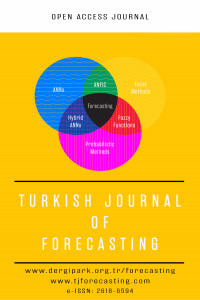The Portfolio Optimization Based on Sharp Performance Ratio
The Portfolio Optimization Based on Sharp Performance Ratio
In recent years investors evaluate their portfolio using modern portfolio theory developed by Markowitz while in the past they evaluated portfolio types according to the traditional portfolio theory based on simple diversification. In modern portfolio theory, it has been defended that the relationships among financial assets included in the portfolio should be taken into account. In addition, the return and risk of the portfolio can be calculated by the mean-variance model. Investors always expect the maximum return and the minimum risk. Therefore they want to choose the optimum one. In Economics literature there are some measurements to evaluate the performances of the different portfolios. In this study, it is aimed at the portfolio analysis to do for the data of the BIST 30 index. For portfolio optimization, some Artificial Intelligence techniques such as the Genetic Algorithm and Particular Swarm Optimization were used for the data belonging to the year 2018. In these algorithms, different values for the parameters were tried and Sharp Performance Ratio (SPR) was used as a performance criterion. The portfolio found with the maximum SPR has been determined as the optimum portfolio. Finally, the risk and the expected return of the portfolio, the included financial assets and their weights have been obtained. The values of the parameters of the final result are considered as the best.
Keywords:
The portfolio Optimization, Genetic Algorithm Particular Swarm optimization, Sharp Performance Ratio,
___
- Shenoy, C. and K.C. McCarthy, Applied portfolio management. 1988, John Wiley & Sons, Inc., New Jersey.
- Reilly, F.K. and K.C. Brown, Investment analysis and portfolio management. 2002: 中信出版社. Canbaş, S. and H. Doğukanlı, Finansal Pazarlar. Baskı, Karahan Kitabevi, Adana, 2007.
- Markowitz, H., Portfolio Selection, Efficent Diversification of Investments. 1959: J. Wiley.
- Sharpe, W.F., Security prices, risk, and maximal gains from diversification: reply. The Journal of Finance, 1966. 21(4): p. 743-744.
- Aksoy, E., Uluslararası Portföy Yönetimi,(1. baskı). Ankara: Detay, 2014.
- Diyar, A., T. Çetinyokuş, and M. Dağdeviren, Portföy Seçimi Problemi İçin Kds/Ga Yaklaşımı. Gazi Üniversitesi Mühendislik-Mimarlık Fakültesi Dergisi, 2002. 17(4).
- Oh, K.J., T.Y. Kim, and S. Min, Using genetic algorithm to support portfolio optimization for index fund management. Expert Systems with Applications, 2005. 28(2): p. 371-379.
- Lai, K.K., et al. A double-stage genetic optimization algorithm for portfolio selection. in International Conference on Neural Information Processing. 2006. Springer.
- Lin, C.-M. and M. Gen, An effective decision-based genetic algorithm approach to multiobjective portfolio optimization problem. Applied Mathematical Sciences, 2007. 1(5): p. 201-210.
- Skolpadungket, P., K. Dahal, and N. Harnpornchai. Portfolio optimization using multi-obj ective genetic algorithms. in Evolutionary Computation, 2007. CEC 2007. IEEE Congress on. 2007. IEEE.
- Lin, C.-C. and Y.-T. Liu, Genetic algorithms for portfolio selection problems with minimum transaction lots. European Journal of Operational Research, 2008. 185(1): p. 393-404.
- Chang, T.-J., S.-C. Yang, and K.-J. Chang, Portfolio optimization problems in different risk measures using genetic algorithm. Expert Systems with Applications, 2009. 36(7): p. 10529-10537.
- Soleimani, H., H.R. Golmakani, and M.H. Salimi, Markowitz-based portfolio selection with minimum transaction lots, cardinality constraints and regarding sector capitalization using genetic algorithm. Expert Systems with Applications, 2009. 36(3, Part 1): p. 5058-5063.
- Chang, J.-F., T.C. Wang, and Y.-T. Min. Using Genetic Algorithms to construct a low-risk fund portfolio based on the Taiwan 50 Index. in Computational Aspects of Social Networks (CASoN), 2010 International Conference on. 2010. IEEE.
- Zhu, H., et al., Particle Swarm Optimization (PSO) for the constrained portfolio optimization problem. Expert Systems with Applications, 2011. 38(8): p. 10161-10169.
- Lu, F.-Q., et al., Credit portfolio management using two-level particle swarm optimization. Information Sciences, 2013. 237: p. 162-175.
- Golmakani, H.R. and M. Fazel, Constrained Portfolio Selection using Particle Swarm Optimization. Expert Systems with Applications, 2011. 38(7): p. 8327-8335.
- Sun, J., et al., Solving the multi-stage portfolio optimization problem with a novel particle swarm optimization. Expert Systems with Applications, 2011. 38(6): p. 6727-6735.
- Chen, W. and W.-G. Zhang, The admissible portfolio selection problem with transaction costs and an improved PSO algorithm. Physica A: Statistical Mechanics and its Applications, 2010. 389(10): p. 2070-2076.
- Holland, J.H., Adaptation in natural and artificial systems. An introductory analysis with application to biology, control, and artificial intelligence. Ann Arbor, MI: University of Michigan Press, 1975.
- Karaboğa, D., Yapay Zeka Optimizasyon Algoritmalari. 2014.
- Kennedy, J.-E., R. Particle swarm optimization. in Proceedings of IEEE International Conference on Neural Networks IV, pages. 1995.
- De Jong, K.A., Analysis of the behavior of a class of genetic adaptive systems. 1975.
- Schaffer, J., R. Caruana, and L. Eshelman. R. Das. 1989. A Study of Control Parameters Affecting Online Performance of Genetic Algorithms for Function Optimization. in Proc. Third International Conference on Genetic Algorithms. Morgan Kaufmann. Cited in Mitchell. 1999.
- Grefenstette, J.J., Optimization of control parameters for genetic algorithms. IEEE Transactions on systems, man, and cybernetics, 1986. 16(1): p. 122-128.
- Shi, Y. and R.C. Eberhart. Parameter selection in particle swarm optimization. in International conference on evolutionary programming. 1998. Springer.
- Yayın Aralığı: Yılda 2 Sayı
- Başlangıç: 2017
- Yayıncı: Giresun Üniversitesi
